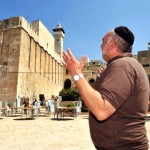“‘Go back and tell Hezekiah, the ruler of my people, ‘This is what the Lord, the God of your father David, says: I have heard your prayer and seen your tears; I will heal you. … I will add fifteen years to your life. And I will deliver you and this city from the hand of the king of Assyria. I will defend this city for my sake and for the sake of my servant David.”‘” (2 Kings 20:5–6)
The royal seal of Hezekiah, the Judean king whom God healed from a deadly disease, has been discovered in the ancient royal quarter of Jerusalem. This a first-of-its-kind discovery related to any Israel or Judean king reveals not only the veracity of Scripture, but also the long history of the Jewish People in Israel.
Israeli Prime Minister Benjamin Netanyahu expressed excitement about the discovery after it was announced on Wednesday, connecting it to the approaching Chanukah holiday that focuses on the Maccabees’ restoration of the Temple.
“The find is further evidence of the deep connection between the Jewish people and Jerusalem, our eternal and undivided capital. It is also another refutation of the absurd claim that we are colonialists in a foreign land,” Netanyahu said in a public statement.

The Ophel is located in Jerusalem between the City of David and the southern wall of the Temple Mount.
In a formal excavation of the Ophel, an elevated area between the palace of the City of David and the southern wall of the Temple Mount, a team of scientists and archaeologists from Hebrew University of Jerusalem discovered the oval impression of Hezekiah’s seal, who ruled the kingdom of Judah 727–698 BC, during the First Temple period.
The royal impression was inscribed in clay that measures 3 mm thick and 9.7 by 8.6 mm across. The edge of King Hezekiah’s ring also left its mark around the impression. It’s back shows indications of course fabric, likely from being used to seal sacks of foodstuffs. (Arutz7)
While similar seals have been available in the antiquities market since the 1990s with, perhaps, questionable origins, “this is the first time that a seal impression of an Israelite or Judean king has ever been uncovered in a scientific archaeological excavation,” said Hebrew University’s Dr. Eilat Mazar, a world-renowned archaeologist and director of the dig site on behalf of Hebrew University in Jerusalem. (Ynet)
“Belonging to Hezekiah [son of] Ahaz king of Judah,” states the seal in ancient Hebrew. At the center of the artifact, a sun bears two wings that point downward and are bracketed by two ankhs — an ancient symbol of a cross with a handle that represents life.
Mazar said that Hezekiah changed the symbol of his own identity and of the royal administrative authority from a scarab to a “protector” sun late in life. (Jpost)
“The change most likely reflected both the Assyrian influence and Hezekiah’s desire to emphasize his political sovereignty, and Hezekiah’s own profound awareness of the powerful patronage given his reign by the God of Israel,” Mazar added.
This special addition of the symbol of life may support the assumption that the change on the king’s personal seal was made after Hezekiah had recovered from the life-threatening illness of leprosy, when the life symbol became especially significant for him [in 704 BC],” Mazar said.
Mazar’s grandfather, Prof. Benjamin Mazar “pioneered the excavations just north of the City of David on what is known as the area of the biblical Ophel. Following history backward, Professor Mazar and his crew dug every summer for a decade before they reached a wall dating to the First Temple period,” writes The Trumpet.
Eilat Mazar picked up her grandfather’s work on First Temple excavations in 1986. She now directs digs in both the City of David and the Ophel Archaeological Park, which is part of the National Park Around the Walls of Jerusalem, which is overseen by the Israel Nature and Parks Authority.
Renewed discovery efforts of the Ophel, began six years ago with funds from New York residents Meredith Berkman and Daniel Mintz. The seal was found during the wet sifting phase of the excavation, directed by Dr. Gabriel Barkai and Zachi Dvira, and the writing on the seal was deciphered by Reut Ben-Aryeh. (huji)











